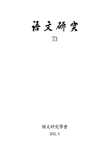학술논문
해방 이후 한국인 이름의 특성 및 변천 양상에 대한 사회언어학적 연구
이용수 660
- 영문명
- A Sociolinguistic Study on Characteristics of Names of Korean People and their Transitional Aspects
- 발행기관
- 어문연구학회
- 저자명
- 강희숙(Hui-suk, Gang) 양명희(Myung-hee, Yang) 박동근(Dong-geun, Park)
- 간행물 정보
- 『어문연구』語文硏究 第73輯, 33~60쪽, 전체 28쪽
- 주제분류
- 어문학 > 한국어와문학
- 파일형태
- 발행일자
- 2012.09.28
6,160원
구매일시로부터 72시간 이내에 다운로드 가능합니다.
이 학술논문 정보는 (주)교보문고와 각 발행기관 사이에 저작물 이용 계약이 체결된 것으로, 교보문고를 통해 제공되고 있습니다.

국문 초록
본 연구에서는 한국인들이 살아오면서 축적하고 있는 언어문화 가운데 하나로, 한국인 이름의 전형적 특성은 무엇이며, 그러한 특성은 시대별로 어떠한 변화를 겪고 있는가를 파악하기 위하여 해방 이후 시기인 1950년대부터 2000년대까지 50년간에 걸쳐 출생한 한국인 이름의 특성을 사회언어학의 연구 방법론 가운데 하나인 계량적 방법을 통해 분석하였다.
이러한 연구 목적을 수행하기 위하여 본 연구에서는 서울 지역 60,000명, 광주·대전·대구 등 지방 대도시 지역 61,200명, 전라도·충청도·경상도 군 지역 61,200명 등 총 182,400명의 이름을 표본으로, 각 연대별 이름의 특성 및 그 변천 양상을 이름의 어종별 분포, 중복 빈도, 이름의 첫 글자와 끝 글자의 유형, 음절수, 음절말음의 유형 등에 초점을 맞춰 살펴보았다.
연구 결과, 한자어 이름이 차지하는 비중이 압도적으로 높게 나타나되, 한자어 이름은 여성보다 남성이, 고유어나 외래어 이름은 남성보다 여성이 더 높은 비중을 차지하며, 남성은‘영수>성수, 정호>정훈>지훈>지훈>민준’이, 여성은 ‘영숙>미숙>은영>지혜>민지>유진’이 각 연대별로 중복빈도가 가장 높은 전형적인 이름으로 밝혀졌다. 또한, 이름 끝 글자의 경우, 남성은‘수, 호>훈>현>준’이, 여성은 ‘자, 숙, 순, 희, 옥’ 등이 높은 빈도로 사용되다가 1980년대 이후에는‘영’이나‘은’ 같은 글자가 구성요소로 나타나는 가운데,‘희’가 모든 시대에 공통적으로 출현함으로써 가장 오랫동안 여성 이름을 구성하는 요소로 자리 잡고 있음이 확인되었다.
또한, 이름의 음절수를 분석한 결과, 2음절로 이루어진 경우가 98% 이상의 높은 비중을 차지하며, 1음절 이름의 경우는 남성이, 3음절, 4음절 이상의 다음절인 경우는 여성이 훨씬 더 높은 비중을 차지한다는 사실과 함께, 이름의 끝 음절 말음으로 선택되는 음 가운데 가장 높은 비중을 차지하는 것은 ‘ㄴ’이나 ‘모음’이며, 남성은 모음보다는 자음 ‘ㄴ’이, 여성은 ‘ㄴ’보다 모음으로 끝나는 비중이 더 높게 나타난다는 사실이 확인되었다.
영문 초록
This study aims to identify what typical characteristics of names for Korean people, one of Korean linguistic cultures, are and what changes they have had. For the study, characteristics of names of Korean people who were born for 50 years from 1950s to 2000s were analysed with a use of qualitative method, one of socio-linguistic methodologies.
A total of names of 182,400 persons including 60,000 from the capital area and 61,200 from local areas including Gwangju, Daejeon and Daegu were sampled and analysed with a focus given on distribution of language types, frequency of duplication, types of the first and last letters in the names, the number of syllables, and types of the lat sounds of syllables.
As a result, it was discovered that the occupancy rate of Chinese names was overwhelmingly high. More male names were in Chinese than female names. Names of Korean or foreign origin were usually used for females. The names with the highest duplication frequency were‘Yeongsu>Seongsu, Jeongho>Jeonghun>Jihun>Jihun>Minjun for males, and ‘Yeongsuk>Misuk>Eunyeong>Jihye>Minji>Yujin’ for females. The last letters of the names which were frequently used were ‘Su, Ho>Hun>Hyeon>Jun’ for males, and Ja, Suk, Sun, Hui, Ok’ for females. However, since 1980s, letters such as ‘Yeong’ or ‘Eun’ have appeared as components of the names, but 'Hui' has appeared in the most common for such a long time.
As a result of analysing the number of syllables in the names, it was discovered that more than 98% were made of two syllables. One syllable names were usually used by male subjects and the names with more than three or four syllables were usually found in female subjects. 'ㄴ' or 'vowels' were most frequently used as the last sounds in the last syllables of the names. ' ㄴ ‘ a consonant, was more used for the last sound of male names and ' vowels ' were more used for the last sound of female names.
목차
<국문초록>
1. 머리말
2. 연구 방법
3. 한국인 이름의 특성 및 변천 양상
4. 마무리
참고문헌
Abstract
키워드
해당간행물 수록 논문
- 해방 이후 한국인 이름의 특성 및 변천 양상에 대한 사회언어학적 연구
- 한ㆍ중 초기 모더니즘 시론의 비교 연구
- 김소월 시의 언어미학적 특성 연구
- 미주 지역 한인의 국어교육 전개양상
- 雪峯 姜栢年의 漢詩 硏究
- 광고언어의 동음이표기(同音異表記)에 대하여
- 1910년대 초반 서사적 계몽성의 마지막 모습
- 유치환의 자연시 연구
- 학술논문 문형의 문법적 특징과 담화 기능에 대하여
- 추정과 비추정의 ‘-겠-’의 의미
- 정선방언 운율유형에 관한 연구
- 조선후기 通信使의 贐章 연구
- 일제강점기 3대 전래동화집의 성격과 그 편찬 배경
- 淸陰 金尙憲의 遊仙詩 小考
- 玉所 權燮의 演戱詩 考察
- 『독립신문』소재 『애국가』 의 텍스트 언어학적 특징
- 허균 문학 의식의 기원
참고문헌
관련논문
어문학 > 한국어와문학분야 BEST
- 국어의 줄임말 현상에 따른 언어변이 양상과 문제점
- ‘밈(meme)’을 활용한 고전문학과 문화콘텐츠의 상호 협력과 융복합교육
- 연구 동향 분석을 통해 본 학문 목적 한국어교육 연구의 실태와 제언
최근 이용한 논문
교보eBook 첫 방문을 환영 합니다!

신규가입 혜택 지급이 완료 되었습니다.
바로 사용 가능한 교보e캐시 1,000원 (유효기간 7일)
지금 바로 교보eBook의 다양한 콘텐츠를 이용해 보세요!






